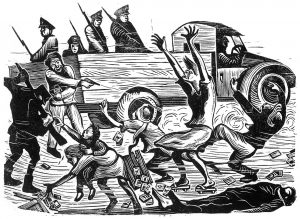
In a sense, tragedy and utopia are simply reflections of one another; that is, visions of utopia are so often born of a desire to escape the tragedies of the present. Conversely, to describe something as a tragedy – one that is traumatic, like a collective nightmare – is to express a profound feeling of betrayal as a vision of utopia is shattered. Such is the case in Taiwan’s turbulent history of the past century, which saw the fall of Japan’s colonial rule followed by the events of February 28th, 1947. The effects of this incident, which divided the local Taiwanese people against the newly-arrived mainlanders, continue to haunt Chu T’ien-hsin, who is herself searching for a utopian escape from the images of degradation and violence of contemporary Taipei.
After reading the Peach Blossom Spring, we are left brooding over the idea that chasing a “utopia” (especially by a totalitarian) may result in tragedy. This is part of the story behind the 228 incident in Taiwan. While there are various factors that contributed to the violence that occurred that day and afterwards; the story of the man that dies chasing the place found by the fisherman brings to light to the destructive nature of chasing a utopia that occurs when the Nationalist Party tries to implement its vision. The stark contrast between the images we get from the Cross-generational Interviews on the 228 Incident video and what we imagine utopia to be show us the extent of how destructive chasing a utopia can be. In the video, we are given images of a terrifying state where there are “banned books” and there is a “white terror”. The testimonies of those that survived it show us how what others may deem as a utopia can be what others see as a “nightmare”. Utopia is an imagined state that is subject to anyone’s own version of it; terror is not. Terror is real and we see the overwhelming similarity in how the 228 incident is discussed in all the texts we analyzed for this day.
Through the juxtaposition of passages from the Peach Blossom Spring with descriptions of contemporary Taipei, Chu T’ien-hsin attempts to recreate the journey of the fisherman in the search for her own utopian dream. Her story is not unlike that of many others who, being nostalgic for a lost past, try, in futile efforts, to recreate that perfect space. Unlike the fisherman, who wanders in the cave at the end of the river, she retraces a path she had once taken, finding herself in an unfamiliar place. Unfamiliar, not because she had never taken this path before, but because the place she found was not the one she expected. Perhaps more similar to those who try in vain to find the cave using the fisherman’s marks, the map of her memory takes her to an unfamiliar place. Where she expects to find familiar faces, she is met with stares; where she intends to pay respects to a tragedy of the past, she finds a restaurant. On the final pages of the novella, she desperately tries to construct her utopia, only to be confront by the violence, poverty, and despair of the present. She cannot help but grieve in silence: “What is this place?”. The answer to which, reveals the utopian visions she longs for: “A shimmering ocean, a beautiful island, the essential site of our sage kings and wise elders’ destiny.” Interpreting this alongside the Peach Blossom Spring suggests that she does ultimately follow the path of the fisherman; although she fails to find utopia in all the places she looks, it appears as a response to aimless reflection on the place that she finds herself.
In a sense, tragedy and utopia are simply reflections of one another; that is, visions of utopia are so often born of a desire to escape the tragedies of the present. Conversely, to describe something as a tragedy – one that is traumatic, like a collective nightmare – is to express a profound feeling of betrayal as a vision of utopia is shattered. Such is the case in Taiwan’s turbulent history of the past century, which saw the fall of Japan’s colonial rule followed by the events of February 28th, 1947. The effects of this incident, which divided the local Taiwanese people against the newly-arrived mainlanders, continue to haunt Chu T’ien-hsin, who is herself searching for a utopian escape from the images of degradation and violence of contemporary Taipei.

Recent Comments